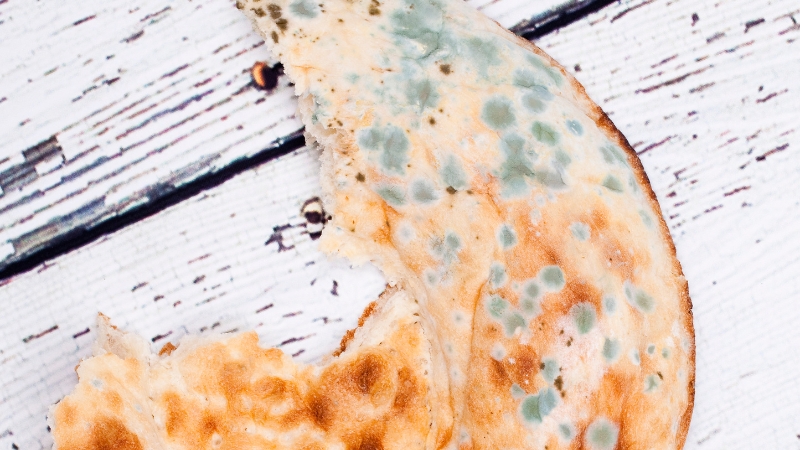The concrete answer is this: most of the time, eating a small amount of moldy bread won’t cause serious harm.
You might experience nothing at all, or you could develop mild digestive symptoms like nausea, stomach upset, or diarrhea.
However, some molds produce mycotoxins, toxic compounds that can cause more severe reactions, especially in people with allergies, asthma, or weakened immune systems.
In short: don’t panic if you swallowed a bite, but don’t make a habit of it either. Let’s unpack why.
How Mold Grows on Bread

Bread provides an ideal environment for fungal growth. It is rich in carbohydrates, retains moisture, and is stored at room temperature, where mold spores can thrive.
Spores are already present in the air, and once they land on bread, they begin producing branching filaments called hyphae, which penetrate the bread’s porous structure.
The visible fuzzy growth on the surface is only the fruiting portion of the fungus. By the time you notice spots, the microscopic root system has already spread deeper, which is why cutting off one patch is not effective.
Factor
Role in Mold Growth
Explanation
Moisture
Critical
Humid conditions accelerate mold activity
Temperature
Room temp ideal
Refrigeration slows growth; freezing halts it
Porosity
High risk
Bread’s structure allows mold to spread internally
Time
Key driver
Mold growth can begin within 3–5 days after baking
Immediate Effects After Eating Moldy Bread
The effects of ingesting mold vary by the type of mold, the amount consumed, and the condition of the person eating it.
Most cases result in no noticeable symptoms, but several outcomes are possible:
- Mild digestive upset: The body may react by producing nausea, abdominal cramps, or temporary diarrhea.
- Allergic responses: People sensitive to mold may develop sneezing, congestion, watery eyes, or skin irritation.
- Respiratory reactions: Chewing moldy bread can release spores into the airway, potentially worsening asthma or causing coughing and shortness of breath.
- Toxic reactions: Rare but serious, some molds produce mycotoxins that can stress the liver or kidneys and are linked to long-term health effects when consumed repeatedly.
Similar concerns apply to expired cheese, where mold growth raises questions about safety and potential health effects.
Types of Mold on Bread and Their Risk Levels
Not all molds carry the same risks. Some are primarily irritants, while others can be harmful if toxins are present.
Mold Type
Visual Appearance
Risk Level
Possible Effects
Rhizopus stolonifer (black bread mold)
Black or gray fuzz
Low to moderate
Stomach upset; very rarely invasive infection in immunocompromised individuals
Penicillium species
Blue or green patches, sometimes with white borders
Moderate
Some species are harmless, others produce mycotoxins, causing nausea or longer-term effects
Aspergillus species
Yellow, green, or black powdery growth
High
Certain strains produce aflatoxins, potent liver toxins and potential carcinogens
Cladosporium
Dark green to black spots
Moderate
Strong allergens can trigger asthma or skin irritation
Mucor species
White fuzz that turns gray
Low to moderate
Mostly mild stomach upset; invasive infections are rare and only in severely immunocompromised
Who Is Most at Risk

While a healthy adult can usually handle accidental mold ingestion without complications, specific groups are more vulnerable.
Group
Reason for Higher Risk
Potential Consequences
Children and infants
The immune system is not fully developed
More likely to experience gastrointestinal illness
Elderly adults
Declining immunity and slower recovery
Greater sensitivity to toxins
Pregnant women
Immune changes during pregnancy
Higher risk of foodborne illness effects
Asthma and allergy sufferers
Sensitive to airborne spores
Respiratory distress or allergic reactions
Immunocompromised individuals
Cannot fight infections effectively
Risk of invasive fungal infection
What To Do If You Ate Moldy Bread
The immediate steps depend on how much was eaten and whether symptoms appear.
- If you ate a small amount and are otherwise healthy, drink water, monitor your condition, and do not expect major illness.
- If you develop stomach upset, rest, stay hydrated, and avoid irritant foods until symptoms pass.
- If you experience allergic reactions, such as wheezing or facial swelling, seek medical care promptly.
- If symptoms persist beyond 48 hours or include severe vomiting, high fever, or breathing difficulty, professional evaluation is needed.
Why Throwing Away the Whole Loaf Is Necessary
View this post on Instagram
Because mold spreads invisibly through bread, discarding only the visible portion does not eliminate the risk.
Hyphae and spores may already exist throughout slices that appear normal. Bread differs from firm foods like carrots or hard cheese, where trimming can remove the contaminated portion.
For bread, any visible mold means the entire loaf is unsafe.
How to Prevent Mold on Bread
Proper storage can reduce the risk of mold contamination.
Storage Method
Effectiveness
Notes
Room temperature, plastic bag
Fastest mold growth
Warmth and humidity accelerate fungal spread
Room temperature, bread box
Moderate protection
Reduces light and moisture, extends freshness
Refrigeration
Slows growth significantly
Bread may dry faster, but it remains edible longer
Freezing
Prevents mold entirely
Bread can be thawed slice by slice without risk
The Bottom Line
@doctorsood 🍞🚫 Is eating around the moldy part of bread really safe? The truth might surprise you. Moldy bread isn’t just what you see on the surface—it’s what you don’t see beneath. Mold spreads its roots deep, even to the parts that look clear, bringing harmful toxins like citrinin that can cause kidney damage. 🩺💀 Can you just cut it off? ❌ Nope, bread is porous, meaning mold and its toxins spread far beyond what you can see. No part is truly safe once mold appears. Plus, pre-sliced bread is especially at risk since more surface area makes it easier for mold to spread. Whole loaves may resist a bit longer, but once mold takes root, it’s unsafe regardless. What about different types of bread? 🍞 Some types of bread—like those without preservatives—are more prone to mold growth, meaning mycotoxins can spread even further. And no, toasting moldy bread won’t save it. 🚫🔥 Heat isn’t enough to destroy the deep toxins; you’d still be eating potentially harmful substances. Play it safe: When you spot mold, it’s time to toss it—no cutting, no toasting. Protect your health and never take the risk. 🛑💯 ✨ Have you ever tried just cutting off moldy parts? Let us know in the comments! 👇 #MoldyBread #HealthTips #FoodSafety ♬ original sound – DoctorSood, M.D.
Eating moldy bread by accident is usually not dangerous for healthy adults, but it can cause discomfort and, in rare cases, more serious issues. The risks rise for vulnerable populations and with molds that produce toxins.
Because mold spreads invisibly, the only safe action when mold appears on bread is to throw away the entire loaf. Bread is inexpensive; the health costs of ignoring mold can be much higher.
Hi there, my name is Kelly Barlow and kellytoeat.com is my blog. Here, I write about various recipes I want to reccommend to readers.
I try to find the best possible recipes that can attract the attention of readers, and at the same time, I strive to write it in the most engaging manner possible.
When I was younger, I wanted to become a chef. Sadly, it wasn’t meant to be, but at the very least, I write about it.
